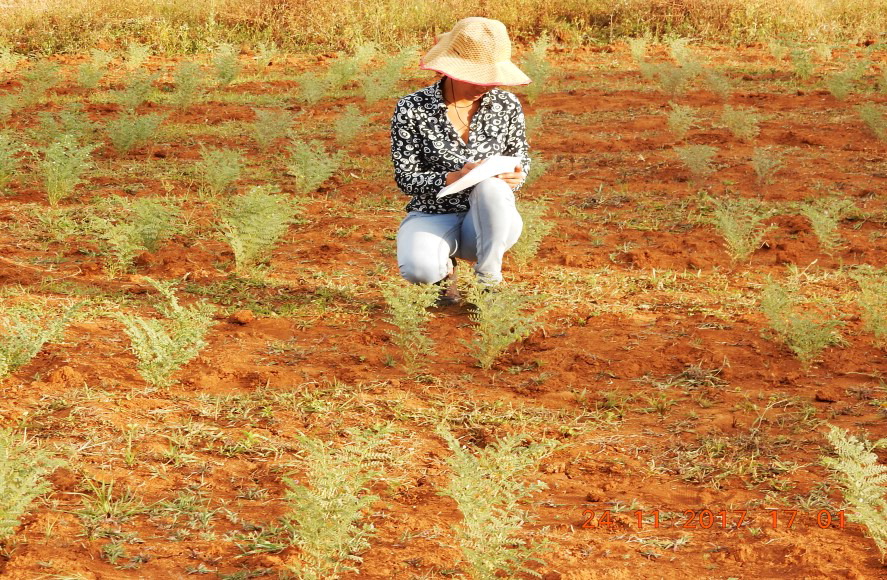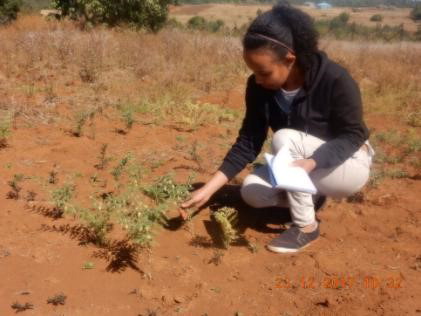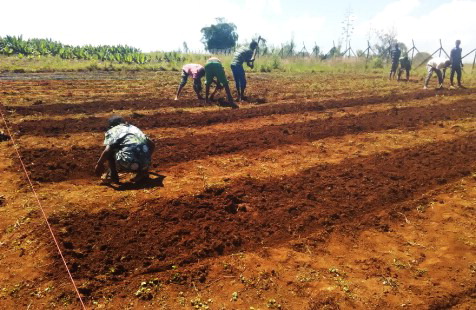|
Cycle 4 (2015 Deadline)
Enhancing food security through improved productivity, nutrition and marketing of chickpea in central and western Ethiopia
PI: Kassahun Tesfaye Geletu (kassahuntesfaye@yahoo.com), Institute of Biotechnology, Addis Ababa University
U.S. Partner: Douglas R. Cook, University of California, Davis
Project Dates: October 2015 - December 2020
Project Overview
Agriculture in Ethiopia forms the basis of the economy, with 80% smallholder farmers. These farming systems are characterized by low yields, widespread use of unimproved landraces, outdated production technologies, and biotic and abiotic stresses. In western and northwestern Ethiopia, soil acidity and consequent aluminum toxicity are a primary limitation to crop productivity, especially for chickpea (Cicer arietinum). Chickpea is the world’s second most widely grown pulse crop and a major source of human protein nutrition, with 40% of Africa’s chickpea crop being grown in Ethiopia. However Ethiopia’s chickpea yields remain low, well below yield potential.
Among the constraints to chickpea production is its sensitivity to aluminum toxicity (Sahu et al., 2010), which is a defining feature of low pH soils that are widely distributed in Ethiopia. It is critical to identify tolerant germplasm and understand the molecular genetic basis of aluminum tolerance. Moreover, because chickpea yields depend on beneficial soil microorganisms, especially nitrogen-fixing symbiotic bacteria and phosphate solubilizing micro-organisms (PSMs), a parallel need is to identify acid/Al-tolerant chickpea
microbes.  |  | | Field data collection by PEER PhD students | Photo courtesy of Dr. Kassahun |
The project is well aligned with USAID’s focus in Ethiopia o n Agricultural Growth-Enabled Food Security, which emphasizes climate change, food security, and nutrition. Developing resilient crops in Ethiopia, such as chickpea tolerant to acid soils, is essential to improving the livelihoods of smallholder farmers.
This project combines expertise in plant breeding and genomics, soil microbiology, and socioeconomics to develop chickpea technology to improve crop productivity and marketing in central and western regions of Ethiopia. The project will leverage the resources and expertise of the U.S. partner by testing wild-cultivated introgression lines, landraces, and elite cultivars for tolerance to acid. In parallel, the project researchers will identify tolerance to acid soils in endemic symbiotic Mesorhizobium and co-occurring PSM populations. Products will be pipelined to national chickpea breeding programs with Ethiopia for variety development and release.
Final Summary of Project Activities
This project was finalized in December 2020.
In Ethiopia, the low productivity of various crops including chickpea is attributed to the use of traditional management practices and various stress factors including soil acidity. Chickpea is widely grown in Ethiopia and serves as a major source of protein. However, its productivity remains low, 1.8 t/ha, well below global average. Hence, this project was amid at identifying tolerant germplasm and microbial inoculants for smallholder farmers in western Ethiopia. Moreover, through value chain, seed system and marketing analysis, we aimed at generating policy recommendations. Overall, significant achievements have been recorded during this project and key findings are presented below.
CORE ACTIVITY 1: Screening genotypes against Al toxicity
The general objective was to screen for Al toxicity under hydroponic condition; multi-locations, characterize F2 and map QTL for genomic region conferring Al tolerance. After several studies and experiments, 20 advanced lines with promising tolerance were handed over to Ethiopian Biotechnology Institute (EBTI) for final evaluation before applying for variety registration at the Ministry of Agriculture (MoA). Currently, these lines are in a bath house on pots with and without lime treatment. Finally, 2-3 best performing genotypes under acidic soil will be presented to Ministry of Agriculture for final evaluation and release. Furthermore, Hawi Negussie is doing her PhD studies through this project in plant genomics and she is ready to defend her thesis in June 2021 at AAU.
CORE ACTIVITY 2: Screening chickpea mesorhizobium strains for acid soils
The aim was to collect chickpea rhizobia from acidic soils of Ethiopia and determine their genomic diversity, and further screen for low pH tolerance and phosphate solubilization under laboratory, greenhouse and field conditions. The genomic diversity with a whole-genome sequence approach showed that 81 Mesorhizobium strains were obtained and estimated with average genome sizes 7Mbp, average depth of 143 X coverage. The pattern of genomic diversity observed indicates the existence of multiple, broadly distributed phylotypes, with no relationship between geographic and genetic distance The result also indicated that 62 strains grew well at low pH 5; and 47 of them were phosphate solubilizers. The strains showed wide diversity in their substrate utilization and tolerance to acidity, high temperatures, toxicity and heavy metals. Under field conditions, the inoculants showed significant improvement in biological nitrogen fixation, growth, yield, nitrogen and phosphorus uptakes of chickpea compared to the commercially available reference strain Cp41. The Natoli variety better performed in many parameters followed by DZ-ck-2011-s-2-0042 variety with the applications of inoculant in the field. Therefore, these inoculants have potential to improve chickpea production in acidic soils in Ethiopia. These 3 inoculants have been handed over to EBTI team for further test for final approval by the Regulatory Authority at MoA. Furthermore, Dr. Atsede Muleta successfully completed her PhD studies in Inoculant Biology through this project and currently she is serving as academic staff at University of Gondar, Ethiopia.
CORE ACTIVITY (3) Seed system study, marketing and value chain analyses
This core activity had two sub-component studies viz. chickpea value chain analysis; and chickpea seed system and marketing study. The study identified two types of chickpea varieties produced in the study area, namely Desi (smaller, reddish brown colored) and Kabuli (larger, cream-colored seeds). In general, Desi varieties are grown for home consumption whereas the Kabuli varieties are for markets beyond the production area and export. Like most legumes, the formal seed system for chickpea is poorly developed and most farmers rely on their own farm saved seed, neighboring farmers or the local grain markets. The major problems in the chickpea seed chain are price fluctuation, need assessment gap, disease and pest, limited shelf life of the seed, seed quality, lack of awareness, high seed price, in availability of inputs, seed shortage and lack of supporting institutions.
Supply chains of chickpea are also poorly organized and products move less quickly at high transaction and transport costs between the different trade levels. There are five core actors in the chickpea grain value chain that are similar in all locations of the study areas. These are input providers, producers, traders (collectors, wholesalers and retailers) at different administrative levels, local processors and consumers.
Chickpea is an important source of household food security as well as a cash crop. As estimated by the participants of the FGD, 40% of the product is consumed and 50% is marketed while 10% is reserved for seed. Wholesalers take about 88% of the total volume, while the others actors take up 12% together. To improve the value chain, sufficient supply of Kabuli type seeds, introduction of low-cost technologies for processing, strong support from cooperatives and access to information and finance are highly recommended.
The project team has met with district agricultural officials and experts to share the outcome of the project in smaller groups. Accordingly, they have shared the following potential interventions needed in the chickpea seed system, value chain and marketing:-
• Production: Supply of either crosses or the original Kabuli seed can greatly improve chickpea productivity. To achieve this, seed production schemes should be supported by the federal and regional governments to ensure sufficient supply of the new varieties.
• Processing: Low-cost technologies are required to modernize the processing of chickpea to meet the rising local demands.
• Larger processors, wholesalers and exporters are currently leading the market for chickpea. The chickpea value chain would gain a lot if these companies work together with groups of farmers, and cooperatives.
• Value-chain coordination: Coordination in the chain is crucial to link the actors in terms of input supply, market information, access to finance, and business management. A chickpea business platform is required, both at national level and zonal level.
Furthermore, discussions were made with research institutes and universities to make soil acidity and related issue part of their research agenda for future joint intervention.
 | | Field layout preparation at Endebir site. Photo courtesy of Dr. Kassahun |
Back to PEER Cycle 4 Grant Recipients
|






